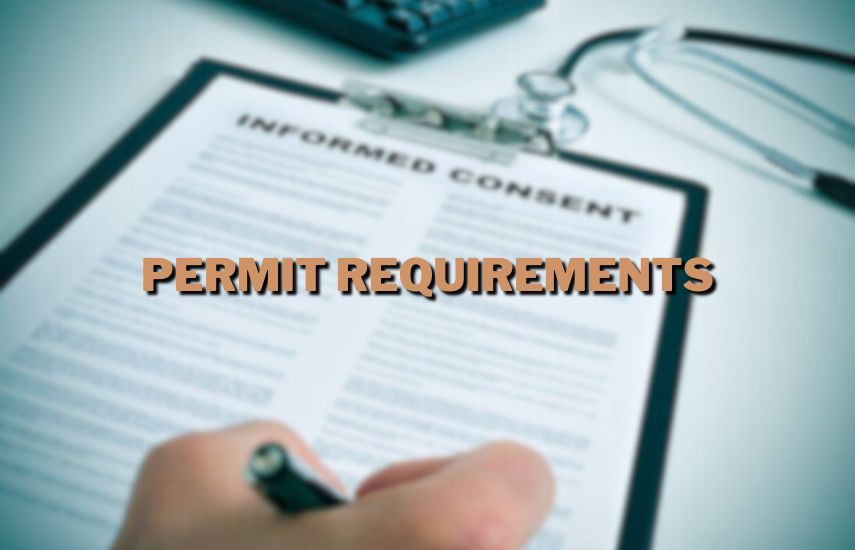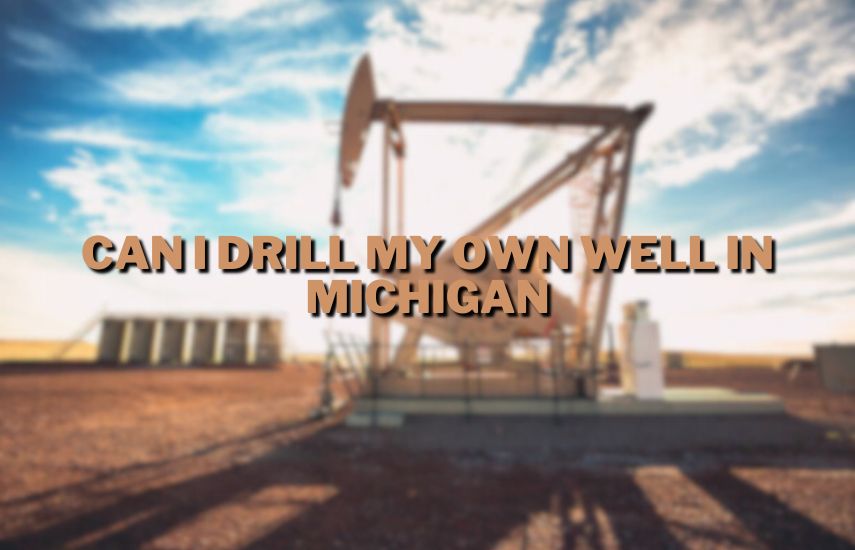You’ve come to the right place if you reside in Michigan and are contemplating drilling your own well. Drilling a well can be an appealing option for those seeking a reliable water source, especially in rural areas or properties with limited municipal water supply.
Before embarking on this endeavor, it’s essential to understand the legal, technical, and environmental considerations involved.
Can I Drill My Own Well In Michigan? Yes, you can drill your own well in Michigan if you are the property owner or have the owner’s written consent.
You must follow all relevant regulations, obtain necessary permits, and ensure compliance with local ordinances and state guidelines to ensure safe and legal well drilling.
In this blog, we’ll explore the ins and outs of drilling your own well in Michigan, offering insights, guidelines, and essential points to consider.
Understanding the Regulations
Before you grab your tools and start digging, the state’s Department of Environment, Great Lakes, and Energy (EGLE) oversees the laws and regulations related to well construction and water quality.
According to Michigan law, any person intending to drill a well must obtain the necessary permits from the EGLE.
Also, do check: How Much To Drill A Well?
Research Michigan’s Well Regulations
Familiarize yourself with the well drilling regulations specific to Michigan. Visit the official website of the Department of Environment, Great Lakes, and Energy (EGLE) to access relevant documents and information.
Determine Ownership And Consent
Ensure you are the property owner or obtain written consent from the owner to drill a well on their property. Without proper authorization, drilling a well may be considered trespassing.
Identify Well Type
Determine the type of well you want to drill. Different rules may apply to various types of wells, such as water supply wells, monitoring wells, or geothermal wells.
Obtain Necessary Permits
Contact the EGLE to apply for the required permits. Depending on the type of well and location, you may need multiple permits, such as a well construction permit and a groundwater discharge permit.
Conduct A Site Assessment
Before drilling, assess the potential impact on the environment and surrounding wells. EGLE may require you to submit a hydrogeological report to ensure the well will not negatively affect groundwater levels or water quality.
Plan The Well Location
Select a suitable location for the well, considering factors like proximity to potential contaminants and access to water. EGLE might have specific setback requirements to prevent contamination.
Drill The Well
With all permits and approvals, start drilling the well using appropriate equipment and techniques. Following industry best practices is essential to maintain water quality and well integrity.
Well Construction Inspection
EGLE may inspect once the well is drilled to ensure it meets its construction standards and guidelines.
Water Quality Testing
After constructing the well, the water quality must be tested to ensure it meets health and safety standards. Periodic testing may also be required depending on usage.
Maintain Records
Keep detailed records of the well construction process, permits obtained, water quality tests, and any maintenance or repairs conducted. These records may be needed for future reference or potential property transactions.
Comply With Ongoing Requirements
Be aware of any ongoing requirements for maintaining the well and regularly check for potential issues like contamination or changes in water quality.
By Michigan’s well-drilling regulations, you can ensure the process is legal, safe, and environmentally responsible.
Permit Requirements

You typically need to follow these steps to obtain a well-drilling permit in Michigan.
Also, check: How Long Does It Take To Drill A Well?
Contact EGLE
Don’t hesitate to get in touch with the regional or local office of the Department of Environment, Great Lakes, and Energy (EGLE), which oversees wells drilling permits for your area.
You can readily find their contact information on the EGLE website or by contacting their central office for assistance.
Application Form
Obtain the necessary application form for the well-drilling permit from EGLE. The form will require detailed information about the proposed well, such as its intended location, depth, and the purpose of drilling (e.g., residential water supply, irrigation, geothermal).
Site Assessment
Conduct a site assessment before submitting the application. This involves evaluating the location’s geological characteristics, potential environmental impact, and proximity to existing wells or potential contaminants. The results of this assessment may be required as part of the application.
Environmental Considerations
Be prepared to address any potential environmental concerns raised during the application process. EGLE may ask you to demonstrate that the drilling will not negatively impact groundwater resources or the surrounding environment.
Water Testing Requirements
Depending on the proposed use of the well and local regulations, you may need to conduct water quality testing before drilling.
The EGLE will provide guidelines and parameters for the required tests to ensure the water is safe for its intended use.
Application Review
After submitting the application, EGLE will review it for completeness and compliance with state regulations. The review process may take some time, so patience is essential.
Approval Or Denial
Once EGLE completes the review, you will receive either approval or denial of your well-drilling permit application.
You will be provided with guidance and instructions regarding the subsequent actions upon approval.
Permit Conditions
If your application is approved, the permit may come with specific conditions you must follow during the drilling process. These conditions could include requirements for well construction, setbacks, and water testing.
Permit Duration
Take note of the permit’s validity period. Some permits expire, so completing the drilling within the specified timeframe is important.
Drilling Process
If your permit is approved, you can proceed with the drilling process according to the guidelines and conditions. It’s essential to adhere to best practices to ensure well integrity and water quality.
Inspections
EGLE may conduct inspections during or after the drilling to verify that the well construction complies with its standards and regulations.
Final Water Testing
After drilling the well, you may need to conduct a final water quality test to ensure the water meets EGLE’s standards for its intended use.
Record Keeping
Keep all the well drilling process documentation, permits, water testing results, and inspections. These records are essential for compliance and may be requested for future reference.
You can obtain a well-drilling permit in Michigan and ensure that your well is constructed safely and complies with state regulations.
Drilling Process
Site Preparation
Before starting the drilling process:
- Clear the area around the designated well location.
- Remove any vegetation, debris, or obstacles that could hinder the drilling equipment or access to the site.
- Level the ground to provide the drilling team a stable and safe working environment.
Drilling Equipment Setup
Set up the drilling equipment, which typically includes a drilling rig, pipes, and other necessary tools. The drilling rig is positioned over the well location, and the drill bit is attached to the drilling pipes.
Drilling
The drilling process begins with the drill bit penetrating the ground. As the bit rotates, it creates a borehole in the earth.
The drilling continues until the desired depth is reached. The depth will depend on the well’s location, water table, and intended use.
Casing Installation
Once the drilling reaches the desired depth, a steel or PVC casing is installed inside the borehole. The casing prevents the well from collapsing and provides a barrier to protect the well from potential contamination. The casing is typically secured in place with cement or grout.
Well Development
After the casing is in place, the well needs to be developed. This process involves removing drilling-related debris, sediment, and loose material from the well to enhance water flow. Development is usually done by pumping water and air into the well and then purging it to clear particles.
Grouting
In some cases, it may be necessary to grout the annular space between the borehole and the casing to prevent surface water from entering the well and to seal off any potential sources of contamination.
Pump Installation
Once the well is developed and the drilling process is complete, a pump is installed to draw water to the surface. The pump type selection will be contingent upon various factors, including the well’s depth and the volume of water required.
Well Testing
After installing the pump, the well undergoes testing to evaluate its performance and water yield. This testing ensures that the well can meet the intended water supply requirements and that the water quality is suitable for its intended use.
Well Completion Report
The well drilling professional or contractor prepares a well completion report that documents all the details of the drilling process, including the well’s depth, casing specifications, construction materials, and water quality test results.
Well Maintenance And Operation
Once the well is completed and operational, regular maintenance is essential to ensure its continued efficiency and longevity.
Routine well inspections, water quality testing, and pump maintenance are essential to keep the well functioning optimally.
Compliance With Regulations
Throughout the drilling process, it’s essential to comply with all relevant regulations, permits, and environmental guidelines set forth by local authorities and the Department of Environment, Great Lakes, and Energy (EGLE) to ensure the well is constructed safely and legally.
Conclusion (Can I Drill My Own Well In Michigan)
In Michigan, you can drill your own well if you are the property owner or have the owner’s written consent.
It is essential to comply with all relevant regulations, obtain necessary permits, and adhere to local ordinances and state guidelines to ensure safe and legal well drilling.
Drilling your own well in Michigan can be rewarding, providing you with a reliable water source for various purposes.
Navigating the regulatory landscape, understanding technical aspects, and addressing environmental considerations require careful planning and expertise.
While some property owners may undertake the well-drilling project independently, hiring a licensed and experienced professional is strongly recommended.
Professionals are well-versed in Michigan’s regulations, possess the necessary technical knowledge, and can handle unexpected issues during drilling.









